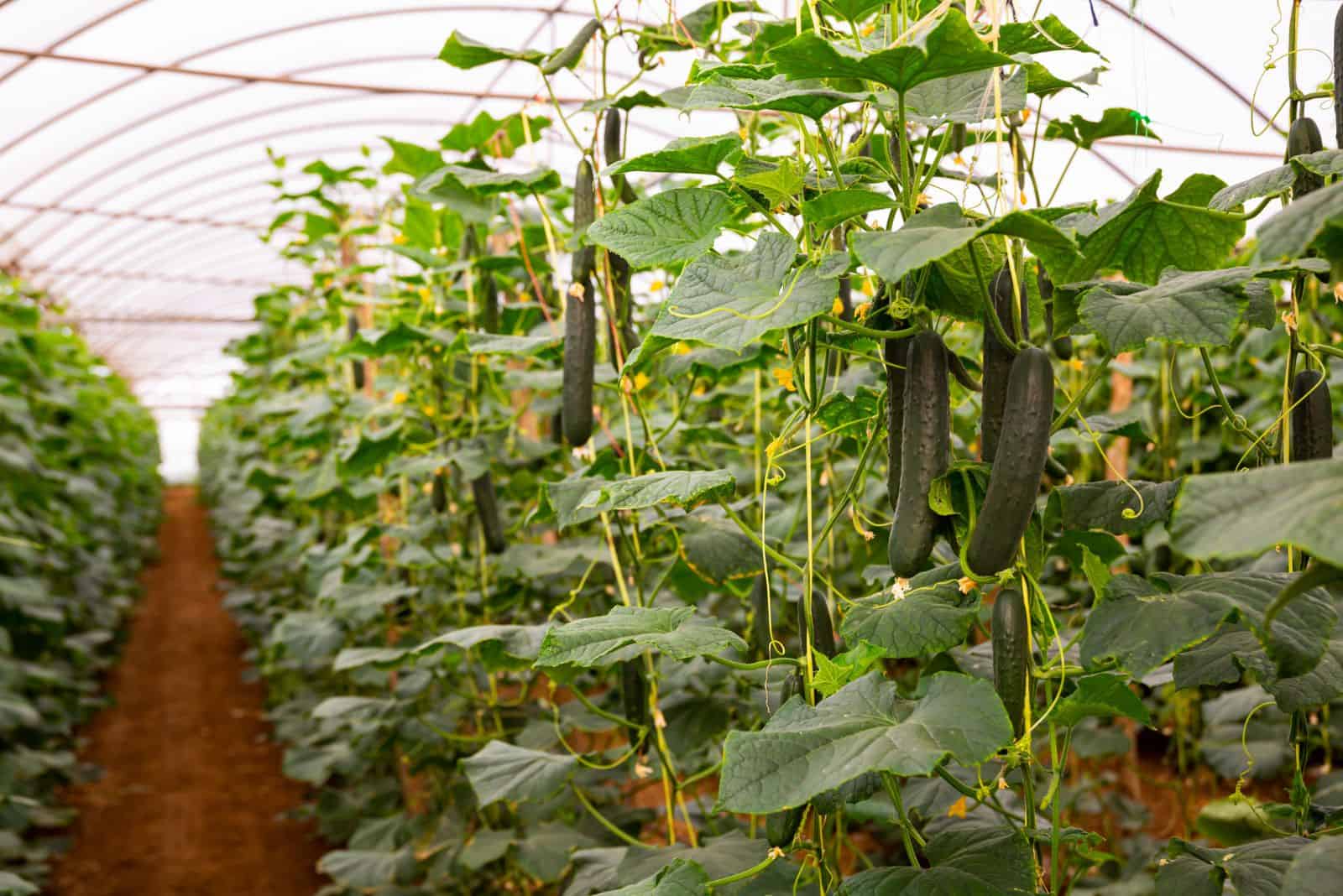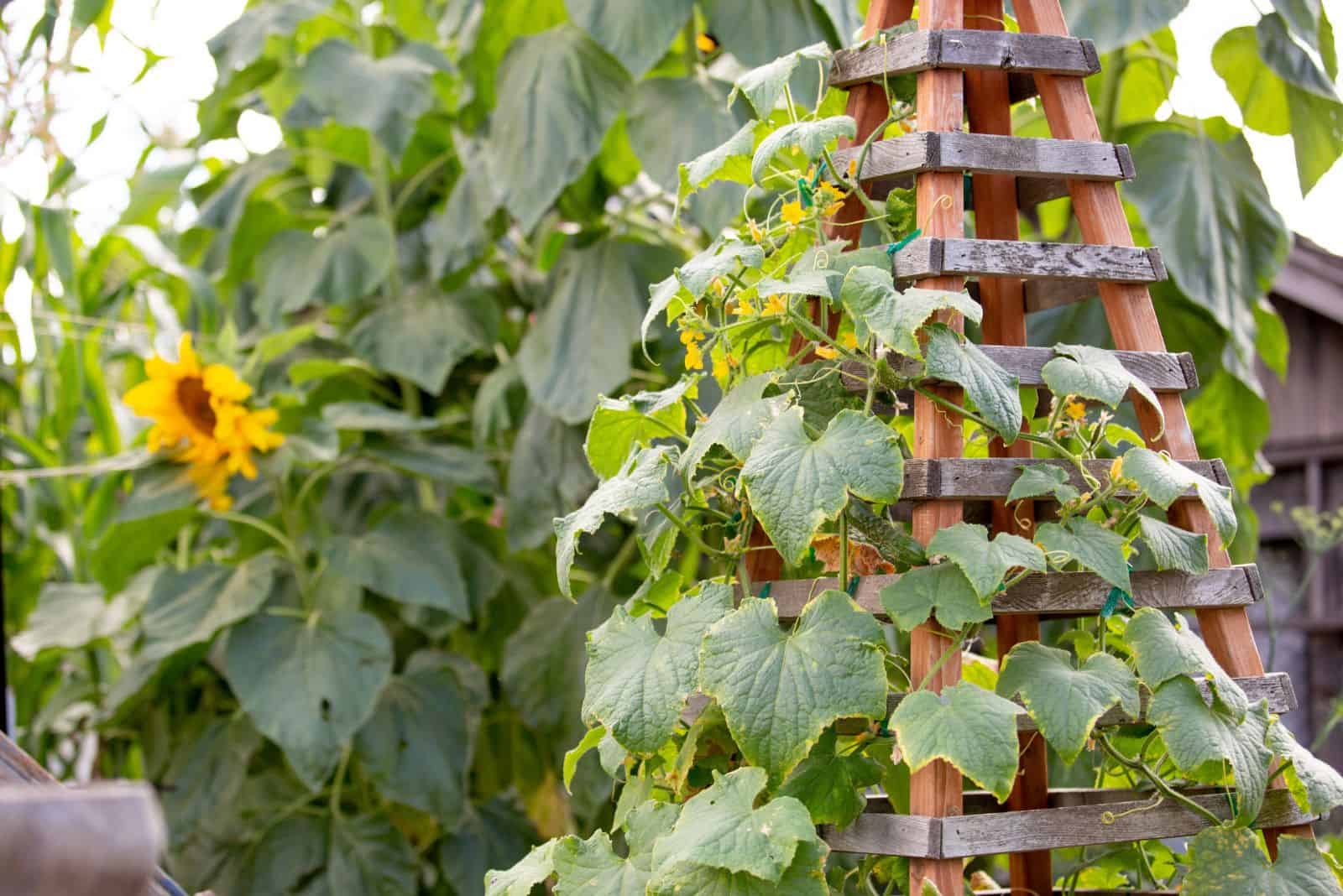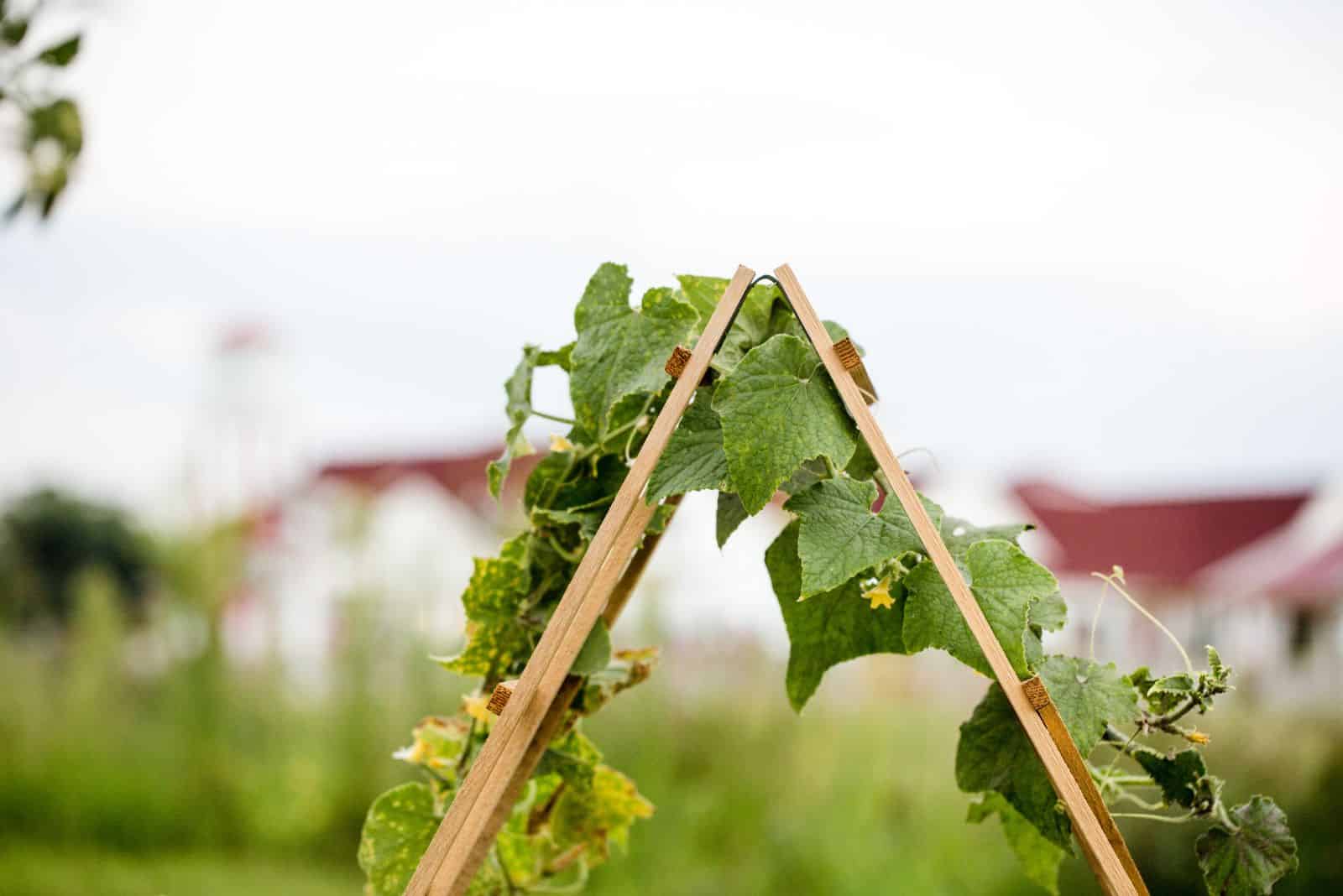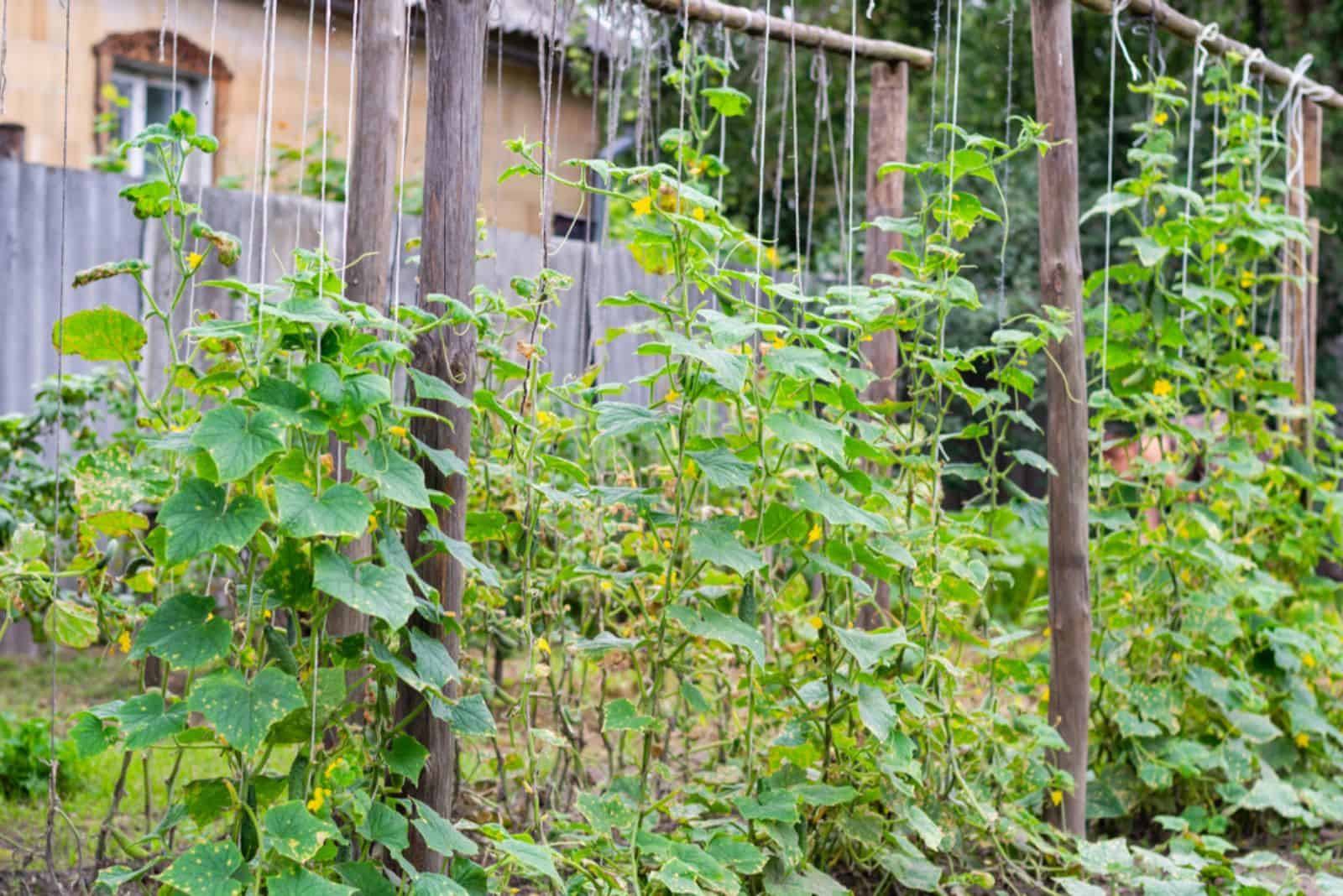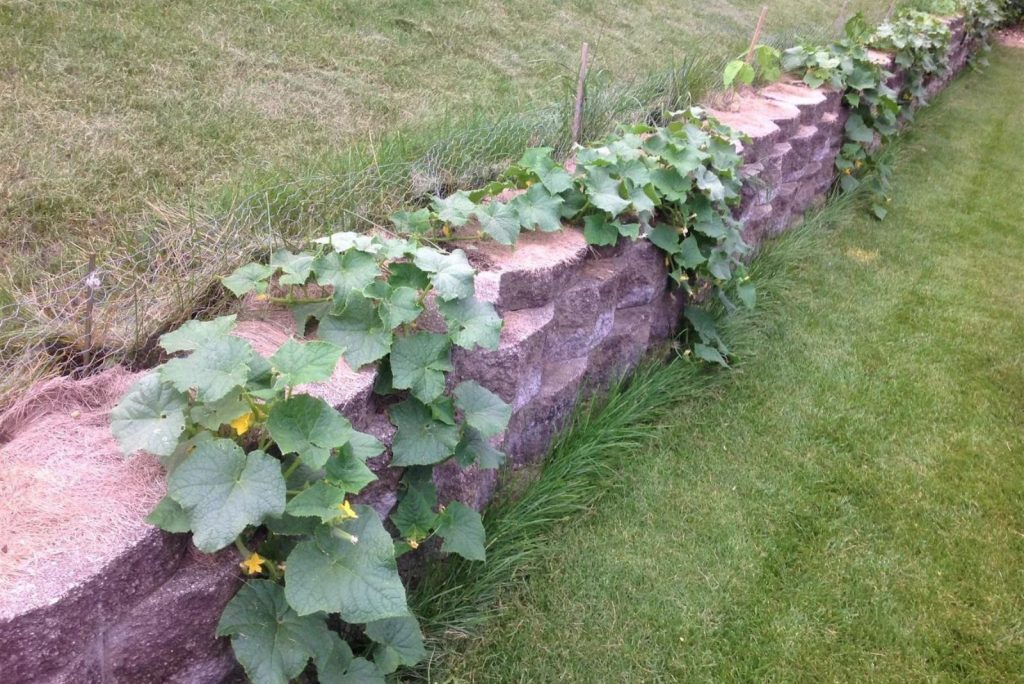Cucumbers are a go-to veggie for beginners as they’re so undemanding and easy to grow.
However, they can crowd your garden and their vines crawl all over the place, preventing you from filling it with more delicious vegetables.
Luckily, you can train cucumbers to grow on trellises, and you can find 12 ideas to get you started right here.
Let’s dive in!
Why Stake Cucumbers In The First Place?
Before we examine all the ins and outs of building perfect trellises and support for cucumbers, let’s first look at some reasons why you should do it.
Nothing’s wrong with letting them grow on the ground, but one of the cucumber growing tips that can yield healthier and higher quality fruit is trellising.
This method is far more suitable for vining than bush varieties, which don’t require that much support when growing.
It Improves The Quality Of Plants And Fruit
Trellising cucumbers will give you more space in the garden and also yield healthier fruit.
That’s because they’re not constantly on the ground where moisture can cause them to rot prematurely.
The plants themselves will also be healthier and safer from pests and diseases. They will have more air circulation as they’re not touching the ground all the time, so you can avoid fungal infections.
Makes It Easier To Tend And Harvest
Another thing to remember is that trellising can make cucumber care and harvesting much simpler. It’ll be easier to water them without wetting their leaves, reducing the risks of fungal infections.
And you won’t break your back every time you have to irrigate or harvest ripening cucumbers.
But trellises aren’t the only option! You can also plant cucumbers in hanging baskets, where they’ll have more than enough room to grow their vines.
Just don’t stop at one vegetable! Cucumbers love companions, and planting other vining species can help you make better use of the space and benefit these veggies.
Peas and beans are one of the first options because they fixate nitrogen and love climbing up poles and stakes. There are also climbing nasturtiums that act as a trap crop, sacrificing themselves for the sake of your cucumbers.
Types Of Trellises For Cucumbers
Trellises will transform your garden, that’s for sure, but which one to use for cucumbers?
Here are some tips and ideas that can get you on the right track or inspire you to take action.
1. A-Frame Trellis
A-frame supports are perfect for various plants and veggies, cucumbers being one of them. They’re also fairly easy to make.
One of the easiest ways is using a cattle panel folded in half.
But if you want to go more natural, there’s also the option of using logs, branches, wooden planks, and bamboo stakes.
However, you’ll have to nail them together, add some horizontal pieces, and use twine or yarn to give your cucumbers more places to attach.
Here’s how you can do it:
2. Tomato Cage
No one said that cage trellises are exclusively meant for tomatoes; you can also grow your cucumbers in these structures!
They’re not too expensive to buy, and you can also put your arts and crafts to work by building one from chicken wire shaped into a cylinder.
3. Free Standing Trellis
Stand-alone trellises are perfect for gardeners who don’t have walls, fences, or other vertical structures where they can install trellises.
Free standing structures are sturdy enough, and you can build them from metal or reclaimed natural materials.
Here’s an idea that has helped many gardeners:
4. Garden Arch
Arched trellises can add more interest to your vegetable garden, and they don’t have to be elaborate.
Sometimes, all you need is a cattle panel and some sturdy material to give it more support. Arch the panels, connect them to the stakes, and that’s it.
You can also adjust this trellis to fit any area, whether it’s big or small. For smaller gardens, you can use just one panel or even cut it in half, and for larger ones, use two or more panels and connect them at the top.
5. Ladder Trellis
The best trellises are those you don’t have to build at all, and using an old step ladder to support your vining cucumbers is one idea.
If you like this look but don’t have the ladder, you can build them yourself. Use bamboo stakes or wood planks, connect them at the top, and place horizontal steps every couple of inches.
You can also connect the sides with horizontal planks or stakes without connecting them at the top to make matters simpler.
Pro tip: If using wood planks, cut them at an angle at the top (about 8 inches) so that you can connect them more easily.
6. Propped Pallet Trellis
If you have some pallets and reclaimed wood sitting in your yard, you can prop them on two posts.
This method is perfect for smaller raised garden beds.
7. Teepee Trellis
Teepee trellises require a bit more construction work than propped pallets, but they’re also suitable for smaller spaces or containers.
And you can always make it larger if you have more plants! Quite versatile, don’t you think?
The best thing about it is that you can give your old materials a new lease of life, especially if you have some twine, bamboo stakes or wooden posts, branches, etc.
Here are some easy-to-follow tips that will give you with a cool trellis in no time:
8. Tent-Shaped Support
These trellises look exactly like A-frames to the inexperienced eye, but there’s a slight difference between the two. Tent trellises don’t necessarily have a strong support.
All you need to do is make a rectangular wooden frame connected only at the top, or use branches to create a semblance of a-frame.
Bury some stakes at the bottom so that you can connect them to the top. You can also lay some bamboo sticks horizontally and tie the twine to them so that you can adjust the trellis as your cucumbers grow.
Or you can build a tent-shaped trellis with PVC pipes.
9. Vertical Fence
One of the easiest ways of supporting vining cucumbers is letting them grow on a fence that’s already there. You can also make one from scratch if you like the rustic look of vegetable gardens.
Those can be wooden fences made from slightly pointed planks or chain-link fences. Either option will give your cucumbers more air circulation, room to grow, and make them look far more appealing.
But you don’t have to go all in when making a fence. Use reclaimed wood or even branches to build it as they’ll still provide enough support.
10. Vertical Post And Twine
It doesn’t get any simpler than sticking a couple of posts into the ground and intertwining some yarn to create a natural trellis.
You can lace the twine around posts, or tie it vertically or horizontally – whichever suits you best. It’s really one of the cheapest trellis ideas out there, especially if you get a good deal on reclaimed wooden fence posts.
Just make sure that the structure is sturdy enough to support plant growth and vines full of fruit!
11. V-Shaped Post And Twine
To make V-trellises suitable for cucumbers, all you need are posts tilted towards outer ends until they form a letter V.
Place a couple of these structures in a single row and tie some string around them so that the cucumbers have something to hold on to.
Finally, place two straight, sturdy posts at each end of the row to provide your trellises with more structure.
Once your cucumbers start growing on it, you’ll see how much light they can get from this structure and how easy it is to pick the fruit.
12. Wall Mounted Trellis
If you don’t have a fence and have little desire to make one just for your cucumbers, you can use a south-facing wall as the basis for a cucumber trellis.
Plant this vegetable in a container or a raised bed right next to the wall and then fasten a mounted trellis to it.
You can get ready-made ones in garden centers or make one yourself. The simplest solution would be to drive hooks into the top and bottom of the wall then connect them with the twine.
Another option would be to use chain-link fencing, bamboo stakes, reclaimed wood, or long branches.
And if you use a sturdier material such as wood or bamboo, you can just lean it against the wall without affixing anything.
There are other ways you can amend or improve these cucumber trellis ideas to fit your vegetable garden or raised bed. You’ll quickly find that only the sky’s the limit.
These ideas will narrow it down for you if you’re not sure where to start, and you’ll certainly find a suitable option.
Until next time!

